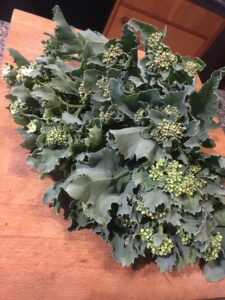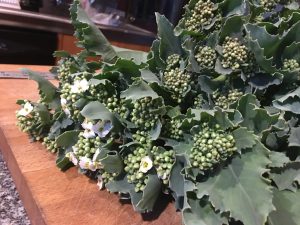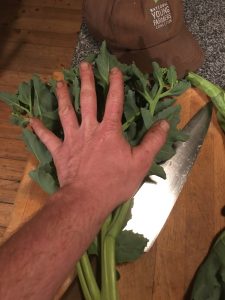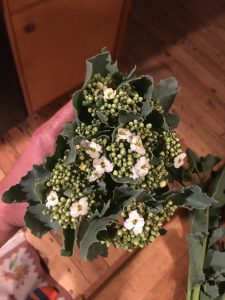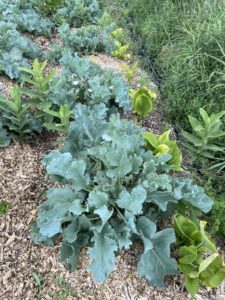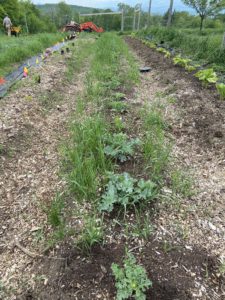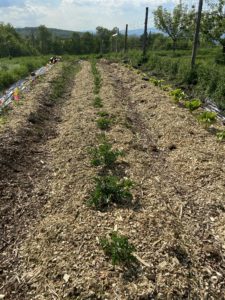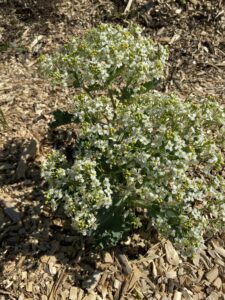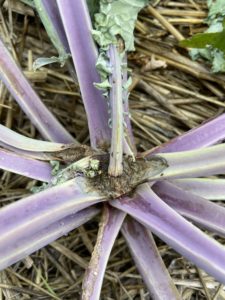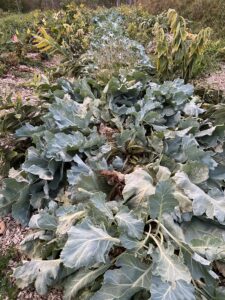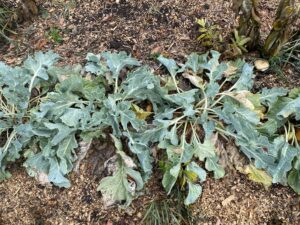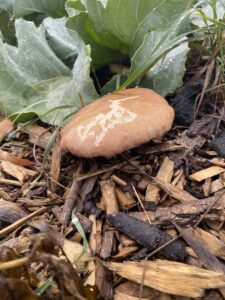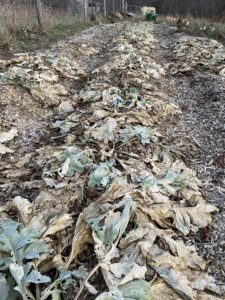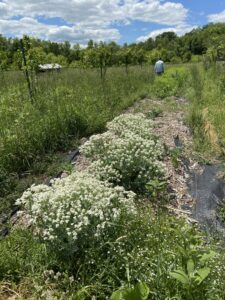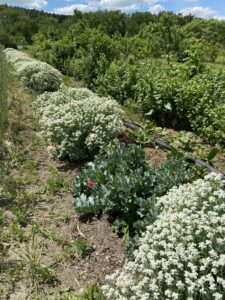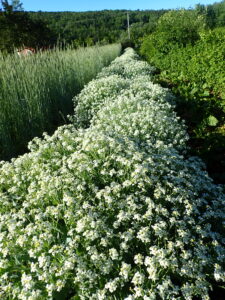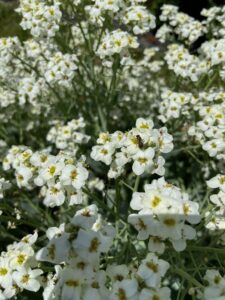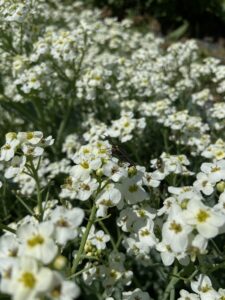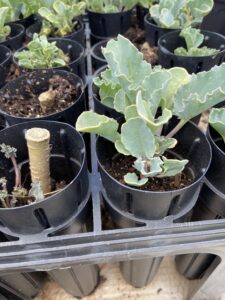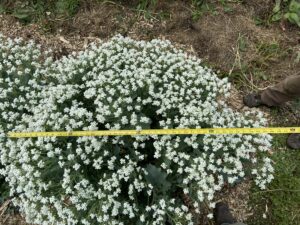Final report for FNE18-895
Project Information
The purpose of this project is to grow and research the perennial vegetable Sea Kale (Crambe maritima), and to develop accessible tools and outreach in order to facilitate and encourage its familiarity and commercial and community adoption among producers, chefs, and the general public. We established and maintained plantings of Sea Kale at two host farm sites in central and northern VT, USA (East Hill Tree Farm, Plainfield; The Farm Between, Jeffersonville). Our direct research includes: 3-4 seasons of maintaining plantings at 2 different host sites, sourcing plant starts and root cuttings, root propagation methods, transplanting, different establishment methods (till and no-till), different soil types, pollinator observations, lbs / plant of Sea Kale broccoli production (our primary yield), and tasting and cooking trials among other things. We completed an accessible (online and printable), 1 page / 2 sided, Commercial Crop Growers' Guide for Sea Kale; we contributed Sea Kale broccolis for nutritional analysis in order to participate in a paper on nutrition in perennial vegetables being authored by one of our project advisors - Eric Toensmeier - and being submitted to the journal Food Chemistry including research from participating farms in northern Europe as well as our plantings here in VT; our research was featured in 7 Days (which has a significant readership detailed further in this Report) by its food writer Melissa Pasanen who visited the plantings, cooked and tasted the broccolis, and shared her experiences with readers; we distributed Sea Kale broccolis to farmers, farmworkers, farming students, caterers, chefs, and community members more broadly for tasting and feedback; we are teaching a workshop on Sea Kale at the NOFA Winter Conference 2022; we are in the final stages of development of a more detailed Enterprise Analysis. Our assessment of this project is that we completed our objectives, in some cases exceeding them, and in some cases needing to adjust them based on the realities of the global COVID pandemic (such as on-farm site visits and tastings, etc.). We feel excited because these objectives were specifically identified as projects and information which were priorities for overcoming barriers to understanding, familiarity, and adoption.
Our objective is to develop a cultural and enterprise analysis for Seakale in order to encourage its adoption into production, sale and consumption in the northeast. We will address the primary barriers to adoption by conducting research trials and providing outreach to farmers with our results: enterprise analysis, practices, yields, site preparation and establishment, best management practices, maintenance needs, cultural requirements, marketing strategies, environmental benefits, propagation and sourcing, as well as recipes for farmers to share with customers.
The purpose of this project is to facilitate and encourage the adoption of Seakale as a common vegetable on farms, in home gardens, in kitchen skillets, and on restaurant menus in VT and regionally.
As we have seen in our own nursery, grassfed beef operation, and business decision making - adopting new enterprises successfully into farm operations requires at the very least careful budget consideration, an understanding of best practices and cultural methods, and a viable market for distributing product.
We have selected Seakale because our own personal experience, and the advice and research of experts in the field, suggests that it is the perennial vegetable which is perhaps the closest to “production ready,” in terms of reliability and marketability. In order to encourage the adoption of Seakale—and to build cultural interest in perennial crops—we propose to establish at least 3 trial plots at our and host partner locations, and work with professional research partners, and farmers to collect data with respect to cultural practices, enterprise budgets, and marketability. A crop guide like this does not exist in the US.
Our Seakale Crop Guide will include enterprise budget, yield, cultural, and market data, which we will publish freely and distribute to farmers, service providers, consumers and food entrepreneurs through a myriad of channels in partnership with project collaborators.
Seakale - and perennial vegetables generally - present unique opportunities with respect to: climate change mitigation, adaptation, and transformation; food security; pest and disease issues; farm labor costs / time; diversifying production calendars; soil conservation; pollinator habitat; and more.
Despite these potential opportunities, there are knowledge and research gaps inhibiting farm scale adoption of Seakale and many of the most promising perennial vegetables. Adopting new enterprises and unfamiliar crops into farm operations will be feasible with a better understanding of Seakale as a crop and market opportunity. One of our project collaborators, Eric Toensmeier, is one of the foremost experts on perennial vegetables in North America, and considers seakale to be one of the top crops worth investigating for commercial production in the Northeast. This is due to its cold hardiness, reliability, 10+ years of productive life and similarity in taste, texture and appearance to commonly-eaten annual vegetables. Eric has advised us that developing enterprise budgets for Seakale and other perennial vegetables is critical to encouraging their wider adoption.
Our technical advisor, Dr. Joshua Faulkner at UVM, works extensively in climate-smart agriculture. He and Eric are both excited about the many environmental benefits of perennial crops in agriculture. Seakale and perennial vegetables reduce tillage, mitigate soil erosion, facilitate carbon sequestration and water infiltration, and reduce fossil fuel and human labor inputs (in comparison to annual vegetable production). Perennial crops grow soil, and they always provide a living cover and root system during the growing season - and a natural mulch on the soil surface in winter. Our management strategy will keep them mulched throughout the year as well, contributing even more to a positive impact on water cycles and soil conservation. Having a perennial crop like Seakale means you have productive beds which don’t require yearly preparation and planting, thus reducing a farmer’s labor and fossil fuel use. Seakale is deeply rooted and drought tolerant, adding resilience to climactic variability to its list of attributes. It also has flowers which are a nectary for pollinators - which our farmer / researcher partner on this project, John Hayden, will observe and provide data and reflections on. Seakale provides a harvest of shoot (in May) and broccoli florets (in early June), which presents farmers with an opportunity to functionally integrate Seakale into their cropping when there are few other crops available for harvest. Future research may explore functional intercropping systems in Seakale beds; enabling growers to harvest other plants after Seakale’s seasonal production window has passed.
Additionally, brassicas face significant pest challenges, notably with flea beetle at establishment and swede midge later in season. Anecdotal evidence from our and other growers’ experiences suggest marked resistance to flea beetles, and a potentially advantageous harvest window with regards to swede midge. Additionally, the perennial plant is more resilient than annual brassicas and appears to recover well from the midge. Seakale is easily propagated by root division - and its adoption by regional growers will present increased demand for its propagation and distribution on farms, in home gardens, and at nurseries. This presents opportunities for new enterprise and employment.
Farmers and gardeners will benefit in a number of ways: having a specialty crop that can be integrated into their farm brand which presents vertical integration opportunities, occupies a unique spring-time harvest window, doesn’t require frequent tillage or seeding, is resistant to common pests of its plant family, is drought tolerant, improves water infiltration, soil conservation, and may require less labor to manage. If this project is successful, there will hopefully be increased interest in, and funding for, researching more perennial crops for commercial production; and more farmers willing to integrate perennial vegetables into their operations.
Graham has been grazing beef cattle for more than a decade in and around central VT. Graham and Aaron were partners in Walking Onion LLC (home to farm scale design and plantings, education, consultation, perennials nursery) and Robinson Hill Beef DBA (seasonal grass-fed beef finishing and sales) for a few years. Graham continues to run Robinson Hill Beef LLC, marketing grass fed and finished beef direct to consumer. Graham and Aaron continue to partner on agroecological research.
Cooperators
- - Technical Advisor
- (Researcher)
- - Technical Advisor
- - Technical Advisor
Research
[Note: all hours recorded here are on site, they do not reflect time driving]
2018
Project Methods for 2018 / Year 1:
- Technical Advisory Phone Calls: considerations and discussions of plant spacing, planting methods, mulches, yields over time, pest and disease, research methods and objectives,
- Joshua Faulkner (4/3)
- Eric T. (4/13)
- Jonathan Bates (4/17)
- Ordering rooted cuttings and root cuttings from Green Light Plants Nursery, PA (Initial conversations in January - order sent in May)
- Phone check-in with Farmer / Researcher, John Hayden (4/25)
- Plants arrived tied together in bunches of 20 or more with rubber bands; those root cuttings without greens were submerged entirely in soil, and those with greens were submerged to the point of the root top, and watered in; they were left in a shady place until planting (5/25)
Sea Kale Trial Planting
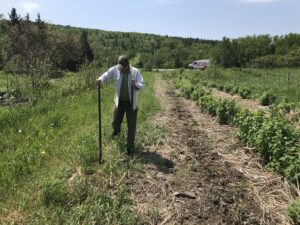
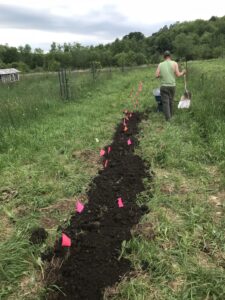
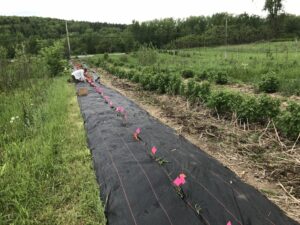
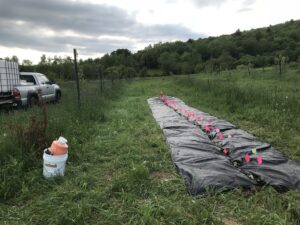
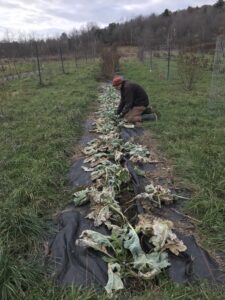
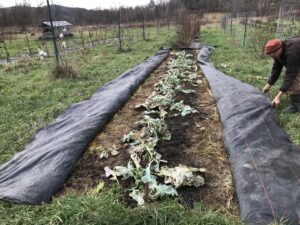
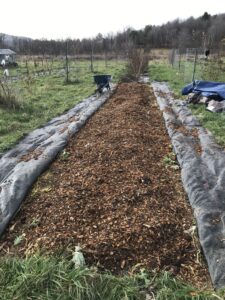
5/28/2018
Site: The Farm Between, John Hayden
Present: John Hayden, Graham Unangst-Rufenacht, Aaron Guman
Present: John Hayden, Graham Unangst-Rufenacht, Aaron Guman
Field #1 Planting:
Preparation, Cultivation, and amendments:
- Soil Testing (many soil cores from the area in a bucket, mix, make sample_
- Broad Fork entire row
- Lime: 50# / 1,000 sq. ft.
- Compost: Approximately 33 cubic feet
- Tie a line at either end of the row to help maintain a straight planting
Total Row Length:
- 147 ft.
Planting:
- Use soil knife, sometimes digging fork, to loosen soil and remove weeds
- Mark each planting hole with flag
- 30 root cuttings @ 3’ spacing
- 33 root cuttings @ 1.5’ spacing
- +1 extra plant
- 64 Total plants
- Root cuttings were planted with root crowns at the soil surface and gently tamped
- Water in all plants
- We rolled out 3’ wide landscape fabric on either side of planting, and used landscape staples to secure it down around plants - leaving the plants an open space between the fabric on either side of the row.
Total Labor for Field Planting #1:
- 11:30 am - 2:53 pm; 2 people
- .25 hrs. Extra for John Hayden (host)
Field Planting #2 (“Polyculture Orchard”):
Preparation, Cultivation, and amendments:
- Same as plot #1
- Compost: app. 21 cubic feet
Total Row Length:
- About 40’
Planting:
- Use soil knife, sometimes digging fork, to loosen soil and remove weeds (did more thoroughly in Site number 2 vs. Site number 1)
- Mark each planting hole with flag
- 25 plants at 1.5’ spacing
- Water in all plants
- Set 3’ wide landscape fabric on either side of planting, and staple down around plants
Total Labor for Field Planting #2, Polyculture Orchard:
-
- 3:10pm - 3:45pm: Graham, Aaron, John H.
- 3:45pm - 4:45pm: Aaron and Graham
- +.5 hours John H.
- Total = 1.5 hrs recorded
Other:
Labor and Materials costs (recorded in receipts)
- Flags (3-4 packs)
- Compost
- Travel
- Time
- Root Cuttings
- Landscape Fabric
---
Sea Kale Trial Plot Maintenance and Fall Check-In
11/12/2018
Site: The Farm Between, John Hayden
Present: John Hayden, Aaron Guman
Labor below is on-site, does not include pickup of woodchip materials and loading onto trailer. Mulching went quite quickly shoveling off of trailer by hand into wheelbarrows and distributing on plants, as we were able to drive very close to each plot.
John Hayden provided the following maintenance labor during Summer 2018, between initial planting day in May 2018 and november maintenance day:
- 2 hrs total watering, 2x waterings in Plot #1 and 1 watering for Polyculture Orchard
- 1 hr early Fall pulling plastic fabric up entirely from Plot #1
Field #1 Planting:
Maintenance:
- Plastic mulch removed completely prior to maintenance day by John during late Summer because there isn’t room to hinge mulch back further (as done in Polyculture Orchard plot) due to proximity to adjacent rows of plants here.
- Light weeding where needed
- Added 2 yards chip, heavy on crowns of surviving plants, plan to use cardboard for mulch in spring for weed suppression and pull chip back on top of cardboard
Total Labor for Field Planting #1:
- Mulching + quick count and observational notes Aaron and John 1 hr together (2 hrs total labor)
Field #2 Planting (“Polyculture Orchard”):
Maintenance:
- Removed fabric staples in plastic mulch in center of planted row, folded back away from plants, leaving other side stapled to act as hinge, then re-pinned side farthest from plants. Help to suppress weeds farther back from row. This was quick and efficient. Light weeding where needed
- Added 1 yards chip, heavy on crowns of surviving plants, plan to use cardboard for mulch in spring for weed suppression and pull chip back on top of cardboard
Total Labor for Field Planting #2:
- Mulching + quick count and observational notes Aaron and John 1 hr together (2 hrs total labor)
_______________________________________________________________________________________________________________________
2019
Project Methods for 2019 / Year 2: (add dates)
- Ordering root cuttings from Aaron Parker (2/14)
- Including phone consultation with Aaron Parker around methods for rooting cuttings
- Rooting cuttings:
- Root cuttings of various size (small & medium from Aaron Parker, large from Jonathan Bates) and are placed on the surface of a moist peat moss bed in standard plastic start trays, with slightly ajar hood over them, out of direct light, attending to with water as needed. (5/10)
- Small = 37 root pieces
- Medium = 58 root pieces
- Large = 25 root pieces
- Potting successful rooted cuttings (beginning 5/23)
- Transplanting successful rooted cuttings into nursery bed at home site (7/5)
- Root cuttings of various size (small & medium from Aaron Parker, large from Jonathan Bates) and are placed on the surface of a moist peat moss bed in standard plastic start trays, with slightly ajar hood over them, out of direct light, attending to with water as needed. (5/10)
- Phone / email check-in with Farmer / Researcher, Nicko Rubin @ East Hill Tree Farm (
- Approval to locate project at East Hill Tree Farm, visit designating locations for trial plots (…../……)
- Transplanting from nursery bed into trial plots at East Hill Tree Farm (9/12)
- Mulching and watering trial plots at EHTF (9/17)
- Phone / email check-in with Farmer / Researcher, John Hayden @ The Farm Between (10/23 email – season in review)
Rooting Cuttings
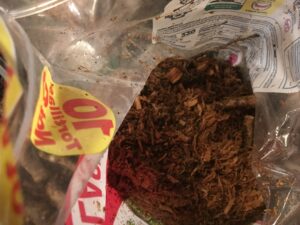
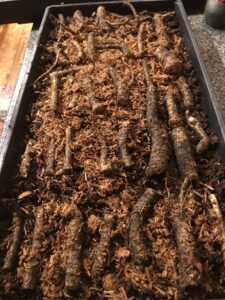
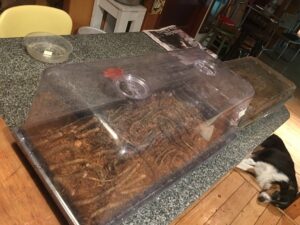
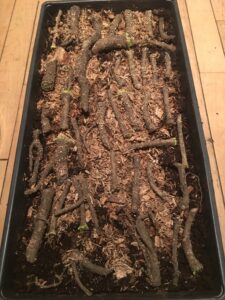
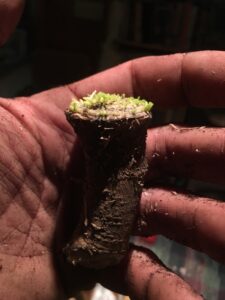
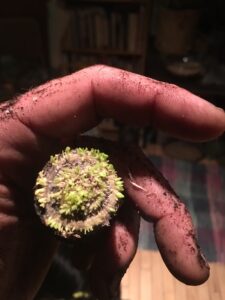
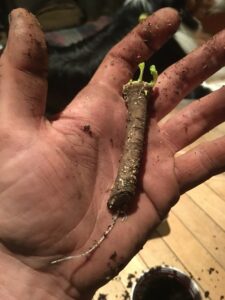
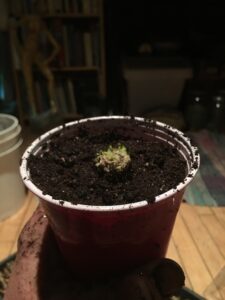
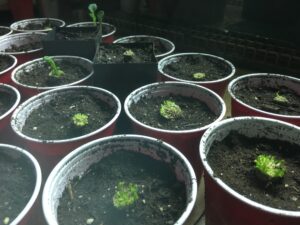
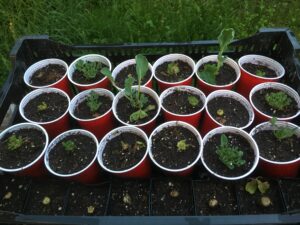
June 4: Sample bunch of Mature Seakale Florets / Brocollis from app. 5 year old plant
Sea Kale Trial Plantings, Farm Between (Year 2)
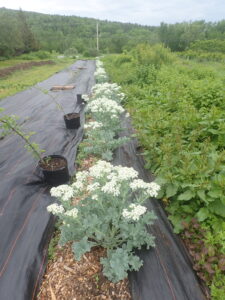
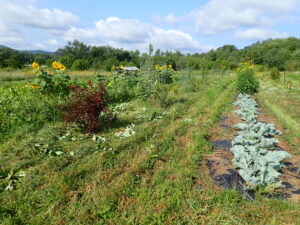
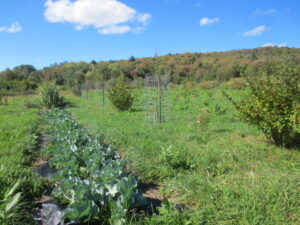
Sea Kale Trial Planting, East Hill Tree Farm (Year 1)
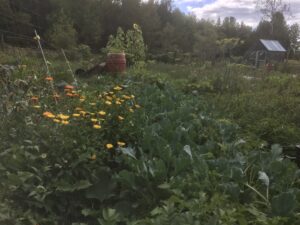
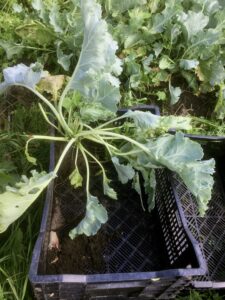
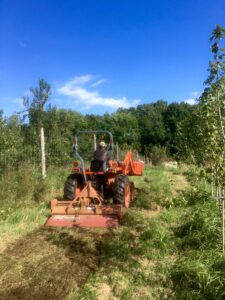
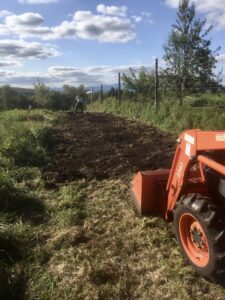
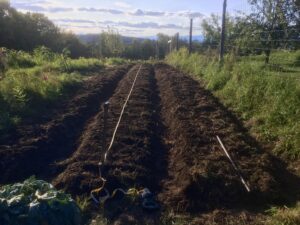
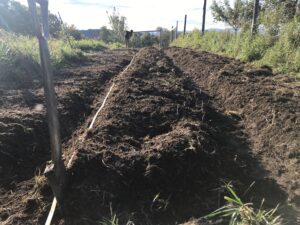
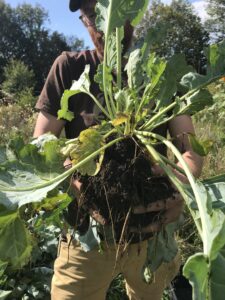
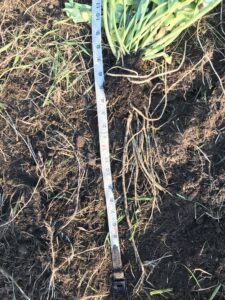
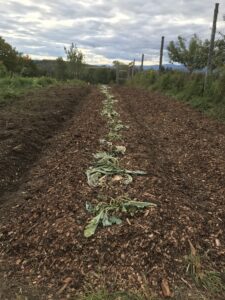
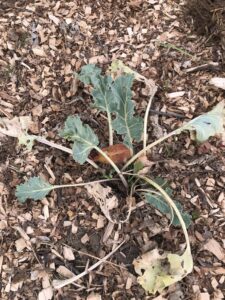
9/12/2019
Site: East Hill Tree Farm, Plainfield, Nicko Rubin
Present: Nicko Rubin, Graham Unangst-Rufenacht, Aaron Guman
Site Prep:
- [Soil tests previously taken by Nicko Rubin, owner of EHTF; who did test analysis and recommended a mineral blend which we made up and applied]
- 2 tractor passes on sod on app. 75’ x 14’ area (for SARE grant and associated Specialty Crop Block Grant plantings – 1/3 of total cost applied to SARE grant as using 1/3 of the space)
- Applied 2.5 yards of compost (1/3 of total cost applied to SARE grant)
- Spread minerals (1/3 of total cost applied to SARE)
- Tilled one more time
- Rake into app. 32-36” beds
Total Row Length:
- 75’
Planting: (9/12)
- Dig seakale from nursery bed into nursery crates, and transport to EHTF
- Plant x number of seakale at x spacing
- Plant x number of seakale at x spacing
- Water in planting
- (9/17) Apply 7 yards woodchip and water
- (11/3) Planting x number of mature sea kale transplants in nursery bed at EHTF
Total Labor for EHTF Planting and maintenance (2019):
- 9/12:
- Graham and Aaron: 2.25 hrs ea = 4.5 total
- Nicko: 1 hr
- 9/17:
- Graham and Aaron: 1 hr ea = 2 total
- 11/3:
- Aaron: 1.25 hrs
2020
Project Methods for 2020 / Year 3
- Technical Advisory Call: Updates, checking in, etc.
- Joshua Faulkner (3/3/2020)
- Jonathan Bates (3/22/2020) - specifically about experience growing sea kale, propagating, etc.
- Farmer Partner Call: Plan Spring visit, discuss on-site workshop, chef relationship and tasting, etc.
- John Hayden (3/18/2020)
- Seakale transplants dug out of nursery bed for transplant at EHTF research site; plants 3 yrs old, variety of sizes. Plants put into plastic nursery pots to hold over until planting time. On coldest night bought into garage to protect from freezing, otherwise very little care needed. (4/15/2020).
- EHTF Research Site:
- visit to check early Spring status of Fall transplants (4/21/2020; 4/23/2020)
- Planning Call for supplemental planting and Spring maintenance at EHTF research site (5/8/2020)
- visit to check health of plants in particularly cold and windy period - plants all look fine and very hardy as per our past experience. No plants were noted as lost due to winter 2019-2020. Appears plants are very winter-hardy once established. (5/13/2020)
- Site Work: weeding, directing app. 15 yd. wood chip mulch delivery, some mulching of beds and pathways (6/4/2020)
- Graham: 1.5 hr.
- Site work: mulching, weeding, watering seakale planted 2020 in polyculture bed (6/26/2020)
- Graham: .25
- Aaron: .5
- Site work: weeding, checking moisture levels, plot notes (7/29/2020)
- Aaron: .5 hrs
- Site work: weeding, plot inspection, photos (9/22/2020)
- Aaron: .75 hrs
- Site work: removed landscape fabric from borders and pathways to preserve fabric from winter weather. Mulch and weed. (10/3/2020)
- Aaron: 1.5 hrs
- Graham: 1.5 hrs
- Site work: mulched crowns of seakale before winter. Suggested by Aaron Parker of Edgewood nursery, likely unnecessary based on past experience. Aaron P has had some winter loss with unmulched crowns in past. (11/21/2020)
- Aaron: .5 hrs
- Total Labor at EHTF Site 2020: 7 hrs total Aaron and Graham (including some time making observations, taking photos, etc.)
- Graham: 3.25 hrs
- Aaron: 3.75 hrs
- Farm Between Research Site:
- Planning Call for Farm Between site (5/18/2020)
- Email correspondence with John Hayden (Farm Between site): harvest data, pollinator study, site visit logistics planning (re: COVID) (6/6/2020, 6/11/2020)
- Research: John Hayden did sea kale harvest sample for weight May 30, 2020.
- John noted: "I harvested 5 plants (every third plant from the start of the row) yesterday (May 30). 3.75#, 6.25#, 2.5#, 4.5# and 1.5#. I cut all shoots with flower buds on them. Delicious! There was no regrowth or opportunity for a second harvest."
- This gives an average harvest / plant of 3.7#.
- Plants which were harvested had all flower buds cut at peak (prior to broccolis maturing into flowers). Plants were harvested at the point where they first started branching. None of these plants put out additional shoots, suggesting plants will yield once / season. These plants which were harvested did not flower during the 2020 growing season. A question for further inquiry is what harvest pattern is best, for ex. harvesting a plant totally of broccolis every year, or leaving a couple, and whether any harvest patterns have an affect on productivity. For commercial harvest we will want the greatest yield possible without tiring out the plant.
- John noted: "I harvested 5 plants (every third plant from the start of the row) yesterday (May 30). 3.75#, 6.25#, 2.5#, 4.5# and 1.5#. I cut all shoots with flower buds on them. Delicious! There was no regrowth or opportunity for a second harvest."
- Research: John Hayden did pollinator research (June 2020).
- Due to John's selling the his farm this summer and moving with partner to Maine, he had limited time to perform the pollinator study originally planned. John was only able to make observations at The Farm Between, and not able to travel to East Hill Tree Farm planting as originally intended.
- Observations from John: "I did do the pollinator protocol 2x and it was very interesting in a negative way. Very few insects were seen visiting and the ones noted were all different species of flies (mostly Muscids). I did see a few small adult syrphid hover flies visiting which are beneficial predators as larvae. I was not able to capture anyone in photographs. Bottom line is that sea kale, as wonderful as it is, can't also be considered a good pollinator resource."
- More investigation is needed. Aaron took a photo of a carpenter bee on a seakale flower at The Farm Between (see photo below). We will be investigating the question of pollinator value further through online research and reaching out to other growers for experience.
- Plant propagation: John and partner Nancy, experienced nursery plant growers, were able to easily propagate plants, which they both planted at their new homestead on the Maine sea coast, as well as sold to their nursery customers, who received the plants with enthusiasm. John noted "We had some good success propagating plants by taking root cuttings and potting them with the cut surface exposed to air." John and Nancy use 7" root-trainer pots with a 2-3" chunk of root sticking out just a bit above the surface of the growing medium. See photos below.
- Site Work: weeded seakale bed, spread chip mulch, recorded data, took photos and video, updates with John Hayden (6/15/2020)
- Aaron: 3.75
- Graham: 3.75
- Total Labor at Farm Between Site 2020: 12 (John Hayden, Aaron, Graham, including documentation, communication, etc.)
- John Hayden: 4.5 hrs (including communication and measuring yield data from seakale, photos)
- Aaron: 3.75
- Graham: 3.75
East Hill Tree Farm Trial Planting: Year Two
05/08/2020: Seakale shoots beginning to emerge after a cold April with late snows. Notice difference in coloration between plants.
On left 06/04/2020: Small polyculture trial planting, interplanting mature sea kale plants from off-site nursery bed (approx 3-4 yrs old) inbetween hosta plants, with further interplanting of spinach vine.
On right: 07/29/2020: Same planting 7-8 weeks later, note massive growth of sea kale.
06/04/2020: Seakale row with spring weeds; after quick weeding with fork; light compost top dress and mulch. Weeding is easy in loose soils which were tilled and broadforked at establishment, growing rows not trampled, kept under permanent mulch, and very little to no additional water since first few weeks of establishment spring 2019, approx one year prior.
06/15/2020: Seakale in flower.
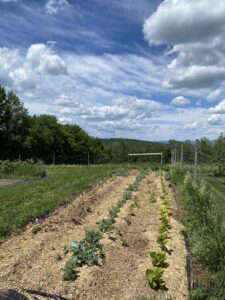
07/29/2020: Seakale row with volunteer milkweed plants, which we left as they did not seem to interfere with our planting and provide additional ecosystem service. Plant post-flower. Minor funk at base of stem of one plant, did not seem to affect plant at all.
09/22/2020: Mid-late September seakale row, milkweed plants.
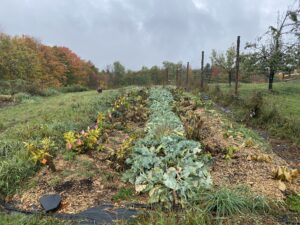
10/3/2020: Mid-September saw one of the coldest frosts in the last century for that time of year in this part of VT; Sea Kale on this site weathered it well.
10/3/2020: Sea Kale and the King Stropharia mushroom, an edible mushroom which grows in woodchips and can be a great ancillary yield in perennial plant systems with woody mulch.
11/21/2020: Sea kale plants foliage provide a nice application of self-generated mulch at the end of the season if left on the plant.
The Farm Between: Year 3
06/15/2020: Our smaller field planting at The Farm Between, in heavy clay soils. Plot has decreased each year. Sea kale do not tolerate heavy, clay, and wet.
06/15/2020: Flowering plants, which were not harvested, on either side of plant which had all edible shoots harvested on May 30 (2 weeks prior). Plants which had all edible shoots harvested did not flower during the season.
06/15/2020: Seakale plant in flower between cover crop (on left) and perennial row of currant (Ribes spp.) on right. Plant has done well in a perennial system with low-input of labor each year. No water since initial planting three springs prior, some occasional compost, mulch, and a quick weeding 2-3x/season. John Hayden was quite please with yield of plants given low input of system.
06/15/2020: Small carpenter bee (Ceratina spp.) on seakale flower.
06/15/2020: Yellow Collared Scape Moth (Cisseps fulvicollis) on sea kale flower.
06/15/2020: Seakale propagated in 7" root trainer pots via 2-3" root cuttings, top exposed above surface of growing medium
06/15/2020: Seakale plant shown at peak flowering with maximum diameter of nearly 3' 9". Plants are quite vigorous after 2-3 seasons of establishment, as this plant in it's 4th season is. Note that this plant was unharvested, and notably larger than harvested plants.
________________________________________________________________________________________________________
2021
Project Methods for 2021 / Year 4:
- Touching Base and Making Plans with Sterling College / The Farm Between:
- Meeting with Charlotte, of Sterling College (new entity owning / operating The Farm Between), in order to discuss the coming year and harvest season: management of the plot, what to do with the harvest, how could we maximize Sterling's role and get more distribution of the plant for tasting and general education, etc. (4/12)
- Following up throughout the Spring pre-harvest with Charlotte and Sarah - the farm manager
- Planning the year, finalizing the research, report, and materials:
- Aaron and Graham meeting (4/14)
- Review and list grant deliverables, focus on Spring next steps, and begin larger mapping of remaining months until project is due
- more of these meetings throughout the Spring and through until the end of the project
- Aaron and Graham meeting (4/14)
- Outreach to Chefs, Farmers, Caterers, Press for tasting and contribution to study
- Draft of outreach communication (4/22)
- Draft sent to a number of folks who are vegetable farmers, chefs, food writers, caterers or some combination thereof
- 7 Days Article, Vermont Farmer-Researchers Explore the Potential of Perennial Vegetables:
- Communications via email and phone with 7Days Food Writer Melissa Pasanen
- she visited the site in Jeffersonville with Aaron and received some broccolis, we had interviews over the phone
- she prepared the Sea Kale and wrote about, and distributed it to others
- Deliveries of samples to various groups and types of people: (end of May)
- stipended farmers, chefs, caterers
- general public of interested folks (farmworkers, gardeners, working professionals, etc.)
- Nutritional Research Contribution Work:
- Researching Specifics for Shipping Broccolis properly and preparing materials and forms (5/27), (5/28)
- Touching base with project advisor and collaborator Eric Toensmeier:
- Specifically on the nutritional analysis, as well as the larger international paper our research will contribute to (5/3)
- These calls continued on an infrequent basis focusing on things from which labs and tests to request to editing the article for submission to Food Chemistry
- Harvesting for Nutritional Assay (6/1), Purchasing equipment for shipping (6/1), and submitting sample (6/2)
- Multiple Calls with Eric about the research
- Work editing and providing information specific to our project, and coordinating information gathering from project partners
- Harvest:
- Harvest Research Methodologies:
- We cut Broccolis from the stem, including a few branchings and potentially small leaves on the harvested portion (see photos below of harvest)
- We placed all broccolis from an individual plant directly into a gallon size ziploc bag (in this case the bags were also delivery vessels for tasters), or into a nursery crate (tared), then weighed, and recorded. When using a nursery crate, we dumped individual plant harvests after being weighed into a larger tote or series of totes for transport.
- There are multiple stems of broccoli per / plant which can be harvested. Stems which are harvested from will not sprout back new broccolis this season.
- Harvest Research Methodologies:
- Sea Kale Commercial Crop Guide Process: (hours of Crop Guide Design Contractor not included)
- 8/20: Research existing crop guides (Extension Services and other University and Ag Service Providers), and Draft Layout of Crop Guide (general sections), and Email Correspondence with Project Advisors Joshua Faulkner and Juan Alvez seeking Crop Guide Designer / Contractor recommendations
- 8/26: Meeting Reviewing Draft and next steps
- 9/4: Meeting touching base on progress of guide among other things
- 9/17: Phone Meeting with Guide Designer / Contractor Sarah Lyman
- 10/4: Drafting content for sections of the Guide
- 10/18: More Editing and work together on the Guide
- 10/24: Further collaborating on final edits
- 10/26: Edits from others incorporated into Guide, and finalizing copy for Sarah Lyman, Contracted Designer
- [minor edits forward by primary authors as well as reviews from project advisors, and other nurseries growing and propagating Sea Kale]
- Enterprise Guide Process:
- Organized and analyzed data from 4 harvest data gatherings which have been conducted during the course of this project
- Worked with project advisor Eric Toensmeier to pull together information into spreadsheets and mirror sample Asparagus crop guide (as a similar perennial crop)
- Further development of spreadsheets and narrative section.
- Conducted price survey range laid out with yield harvest range
- Reached out to project advisors for TA support - next step is further refinement of establishment and management costs based on other vegetable crop management info/standards. Based on this information we will build out yearly cost sheet for establishment, initial years of crop maturing, and mature harvest years following (up to 20+ years).
- Enterprise guide will be finished by end of December and included in our ongoing outreach efforts, published on our landing page, distributed widely, included in our NOFA presentation at the winter conference.
- EHTF Research Site:
- Site work
- 5/4: Travel to EHTF Site to see how plants are progressing
- Graham, .5 hours
- 5/15: Plot Maintenance, Weeding, mulching, monitoring for broccoli maturity
- Graham, .25 hours
- Aaron, 1.75 hours
- 5/22: Weeding and Photographs
- Graham, .5 hours
- 5/24: Harvest Sea Kale for former vegetable farmer and caterer Meghan Wayland who is conducting tasting trials
- Graham, .5 hours
- 5/27: Weeding and Harvest
- Graham, 2.25 hours
- Aaron, 2 hours
- 6/1: Harvest for Nutritional Assay
- Graham, .5 hours
- 8/7: Weeding and Plot Maintenance
- Aaron, 1.25
- 8/15: Weeding and Maintenance, Photos
- Graham, 2.5 hours
- Aaron, 1.25
- 5/4: Travel to EHTF Site to see how plants are progressing
- Site work
- Farm Between Research Site
- Site Work
- 5/20: Interview with Melissa Pasanen at 7Days at the Farm, monitor plants
- Aaron, 1 hour
- 5/26: Sea Kale Harvest and 7Days Photographer
- Graham, 2.25
- Aaron, 2 hours
- Sarah, 2.25 hours
- 5/20: Interview with Melissa Pasanen at 7Days at the Farm, monitor plants
- Total labor on both sites (note that these hours are not reflective of standard farm operations: weighing out plant by plant, time in conversation figuring some this out, time in conversation with interviewers, etc.)
- Graham: 9.25 hours
- Aaron: 9.25 hours
- Sarah (Sterling): 2.25 hours
- Site Work
EHTF: Year 3
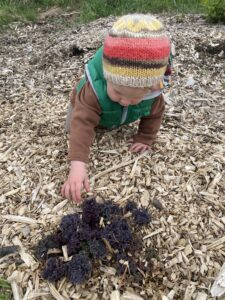
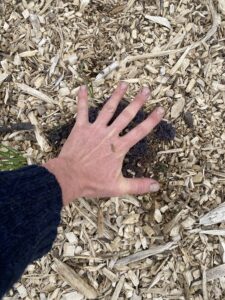
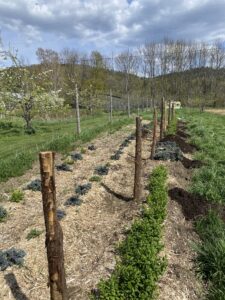
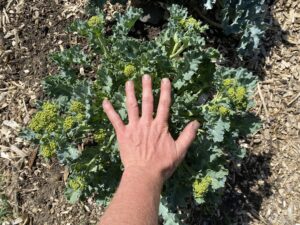
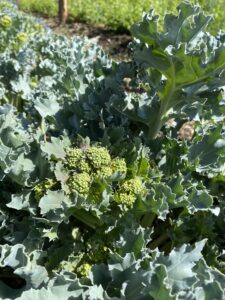
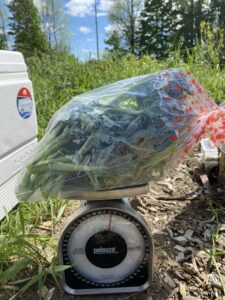
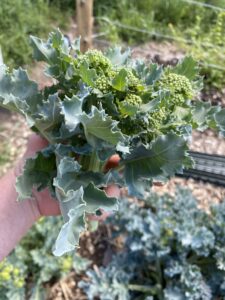
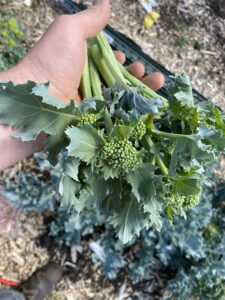
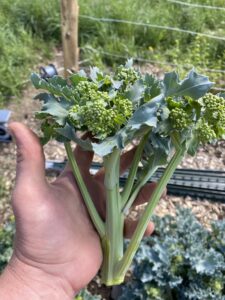
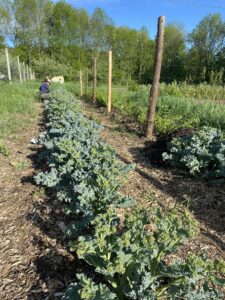
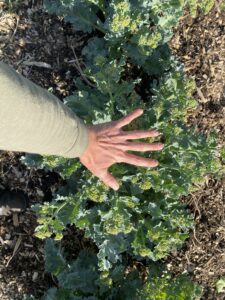
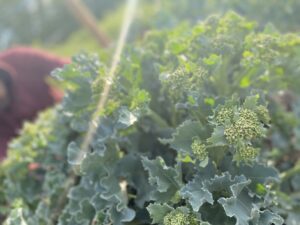
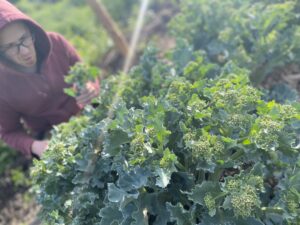
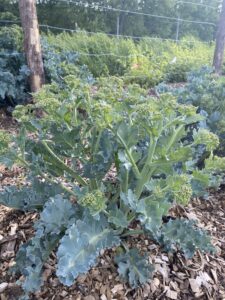
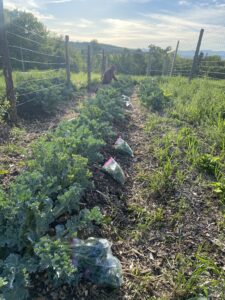
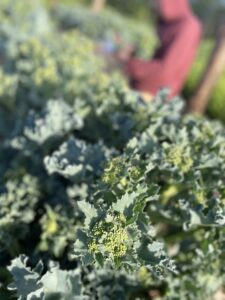
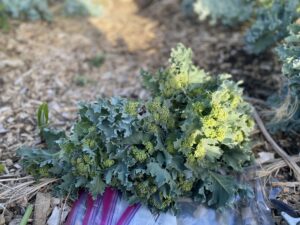
The Farm Between: Year 4 (notably larger plants than the 3rd year plants at EHTF)
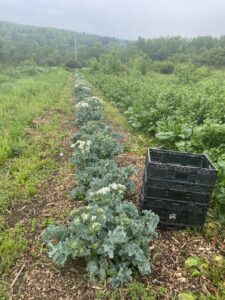
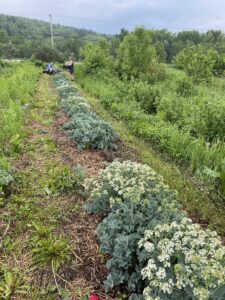
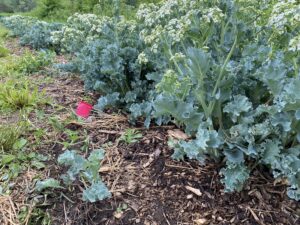
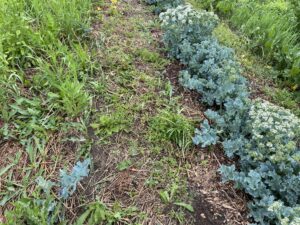
Year 1: 2018
-
Notes on Results and Conditions:
- This planting was done during a dry period which extended from May until mid-late July; and below avg. precipitation for the rest of the growing season through early to mid October
- Very sandy soils in Field #1; "heavier" soils in Polyculture Orchard plot - John Hayden suggests this plot's soils hold moisture better / longer
- Less active cultivation and removal of weeds in part of Plot #1; more thorough in Plot #2
- Survivability was greater in the "Polyculture Orchard" plot
-
Survival rates for season:
-
Field #1:
- Survival rate for season = 43 plants (64 total planted - 67% survival rate)
- Possibly vole damage in plot 1 due to plastic cover? Not 100% sure but saw signs of vole activity near crowns of dead plants
- Also very dry season, watering in plot was infrequent, some plants looked rough going in and may have suffered during course of season
-
Field #2 (Polyculture Orchard): 20 plants (25 total planted - 80% survival rate)
- Despite dry season, good survival rate - if water was limiting factor for plants in Plot 1 it’s possible plants in the Polyculture Orchard plot survived better due to heavier soils here which hold moisture much better.
- Generally plants in this plot were much larger and robust than plants in plot 1
- 1 yard chip here made for very nice thickness of mulch
-
-
-
- Planting was easier when we more thoroughly removed competing roots and loosened the soil
- Root Cuttings:
- We would prefer to plant rooted cuttings / transplants
- We had concerns around the viability of some portion of these root cuttings; some were clearly more healthy and vigorous than others
- Sourcing ideal cuttings and maintaining their health prior to planting was a challenge
-
Questions for Spring (review with Joshua Faulkner)
- Do we add new plants where holes are to fill in plot thickness, even though we would have plants from different years? Do we divide some of the larger existing plants in plot to fill in?
- Look at soil tests and determine whether we will amend plots with minerals - John was in favor of soil amendment.
- Research:
- all of our measurements for planting, applications, etc. are noted in the previous section, "materials and methods"
Year 2: 2019
- Notes on Results and conditions:
- Sourcing of plant material:
- This year we were unable to locate any rooted Seakale cuttings at any of the nurseries we have previously sourced from. We ordered root cuttings as an alternative, and experienced a relatively significant loss of root cutting material in the rooting process as we experimented with two methods presented to us by different nurseries.
- Site location for second trial location:
- We anticipated planting in the Spring at a site in Calais at which we were planning on co-owning and operating a farm based business. Plans changed with respect to living at this site, and co-owning a farm business at this site – so we found a new location at East Hill Tree Farm, in Plainfield, VT. This meant that we weren’t able to plant until later in the season; but we now have a stable and secure site, at which other research, education, and diversified production is already ongoing.
- Site Specific Reporting from John Hayden, Year 2:
- “We did a focus group taste testing with the UVM Farmer Training program and the steamed florets (with black currant vinegar) were universally liked. I sent some to Frank Pace at The Great Northern and he loved it both as florets and with full flowers and wants to order some next year. The plants in the orchard didn't overwinter as well as the sandier soil by the road, but did OK by the end of the season. We will see how they look this spring. I look forward to doing some root propagation this spring also.”
- Bed Prep:
- We decided to use tillage, forming raised beds, and mulching to prepare our planting space as opposed to tarping. This was primarily due to the fact that our planting was pushed out until the Fall (beyond a window for adequate time to kill sod beneath fabric), but also in order to experiment with another common form of bed preparation for vegetable crop production: tillage.
- Questions for Spring
- what will weed pressure look like in the tilled area and how effective will applying landscape fabric for weed control be?
- Research
- all of our measurements for planting, applications, etc. are noted in the previous section, "materials and methods"
- Sourcing of plant material:
Year 3: 2020
- Notes on Results and Conditions:
- East Hill Tree Farm Site Report, Year 2:
- We considered this first year of growth to be a "establishment year" for the plants, and you can see from the photos how much growth the plants put on over the course of the Summer into the Fall.
- We created a "polyculture" bed combining Sea Kale with two other perennial vegetables (Spinach Vine and Hosta). Given the establishment phase of Sea Kale and other perennial vegetables - we are interested in maximizing space and time by exploring intercropping with annual and perennial vegetables.
- Weed pressure (question from previous season) was sufficiently managed with a couple weedings in June and woodchip mulch in applied in tandem. Additionally, borders of trial plot were managed with black plastic in 3'4' wide sheets. Controlling weed pressure at edges helps immensely with ease of plot management. Considering that plot was tilled under and dug for planting from filed/sod, weed pressure has been very manageable with liberal application of woodchip mulch.
- This region of the State experienced a fairly dry summer in 2020
- Farm Between Site Report, Year 3:
- Farm owner and research collaborator John Hayden sold the farm and moved out of State. We have established contact with the new owner to continue the research in this final season. In what we hope is an exciting turn of events, the new owner of the farm is Sterling College, who will be utilizing the farm as a place to research perennial agriculture. We're hoping that they work we're doing in this grant on perennial vegetables may be of interest to them and perhaps they will continue research inquiry.
- John experimented with Sea Kale propagation by root cutting and distributed many plants through his nursery.
- Research:
- Specific Notes are in the previous section, "materials and methods"
- East Hill Tree Farm Site Report, Year 2:
Year 4: 2021
- Notes on Results and Conditions:
- EHTF Site Report
- Sea Kale plants showed marked vigor and success despite it being their 3rd season - we lost none to overwintering.
- Maintenance and weeding was relatively easy given the mulch, and the soil condition allowing for ease of pulling weeds.
- We took up the border of landscape fabric that had been used around the perimeter of the plot for weed control in the Fall. Given weed pressure from the perimeter, we will reapply in the Spring of 2022.
- Our harvests from this site were well timed; full mature heads of broccoli which were not in flower provided excellent eating and were distributed in taste testing.
- Farm Between Site Report
- Sterling College purchase and cooperation in harvest and food preparation was an unexpected development
- We got to our primary harvest of the broccolis at this site as they were beginning to flower, slightly later than desired. The site was harder to monitor given its distance away from us and the fact that those monitoring on the ground there were experiencing Sea Kale for the first time, so gauging how close to flower it was and scheduling our visit was a challenge.
- Sea Kale spreads by root and likely by seed. Walking along the row of plants, one will find many growing a few feet from the central row, and certainly spreading between plants in the row.
- EHTF Site Report
- Research
- Harvests of the marketable portion of the broccolis on plants in their 3rd and 4th year in the ground resulted in a wide range of yields from 1.8 to 3.7 # / plant. This is the approximate equivalent of 4,764 to 9,768 # / acre in field plantings of 6’ between rows and 2.75’ between plants.
- We adjusted budget and research plans - primarily specifically to tasting trials and how we'd collect data - due to the ongoing pandemic and not wanting to host taste testings. We moved from site-based tastings to stipends for farmers / caterers / chefs / food writers to taste trial and briefly write up their results for us.
- more details related to research results is in the "Materials and Methods" section
2018 / Year 1:
In the first year of this 3 year project, we sought to plan, install, and document a Sea Kale planting at the first of two participating farms - the Farm Between in Jeffersonville, VT. We sought to measure survival rates at the end of this first year of establishment, and record other notable conditions, influences, considerations in relationship to this planting. As documented in previous sections, we accomplished these goals, and planted 2 different plantings (as opposed to 1) at The Farm Between in order to test viability in different soil conditions.
Notable conclusions:
- Survivability was greater in the "Polyculture Orchard" plot: 80% vs. 67%
- Planting was easier when we more thoroughly removed competing roots and loosened the soil
- Root Cuttings:
- We would prefer to plant rooted cuttings / transplants
- We had concerns around the viability of some portion of these root cuttings; some were clearly more healthy and vigorous than others
- Sourcing ideal cuttings and maintaining their health prior to planting was a challenge
Year 2 / 2019:
In the second year of this project, we sought to plan, install, and document a Sea Kale planting at the second of two participating farms - the East Hill Tree Farm, Plainfield, VT. We planted in the Fall, and recorded notable conditions, influences, considerations in relationship to this planting. We also maintained correspondence with John Hayden, at the Farm Between, where our first trial plot is planted - tracking maintenance, getting good testimony with respect to soil conditions which may be more favorable, and learning about some taste tasting done with the Beginner Farmer Training Program and a local chef. As documented in previous sections, we accomplished these goals; though the path wasn't entirely as planned.
Notable Conclusions:
- We clearly favor the method of rooting root cuttings of entirely burying the cutting vertically except for app. 1/4 inch above the soil surface over the method of laying the cuttings loosely on the soil surface. The latter method proved unreliable for us, and led to relatively significant root cutting loss through desiccation or mold / wetness.
Year 3 / 2020:
In year 3 our primary goals were monitoring our plantings at both sites, conducting research and maintenance, and hosting events at both sites. The COVID 19 pandemic significantly affected our plans for public outreach and events, however we were able to complete our work and be present at both sites as needed. Our research collaborator and farmer John Hayden has sold his farm, and we now need to be in touch with the new owner in order to determine how to continue our research into this last year of the grant. John Hayden conducted detailed research in Year 3 of the planting at his farm, and we will begin to conduct yield research at the East Hill Tree Farm site this coming season. We saw extremely high survival rates at East Hill Tree Farm after Fall transplanting, close to 100%, and at the Farm Between in the lower field sight between years 2 and 3.
Notable Conclusions:
- Once established in well-drained soils rich in organic matter, sea kale plants are extremely hardy plants that thrive. They need very little input, and can be very low-maintenance to manage if weed pressure is strategically addressed. Weed pressure was not unmanageable at either site, although the establishment method at The Farm Between plot was less labor-intensive (using black plastic vs. tillage and digging a raised bed). At The Farm Between, establishment with black plastic which was in year 2 folded back again from the plants with mulch added, worked very well and proved very low input in terms of labor. The Farm Between has found that with mature plants, 2-3 fairly quick weeding rounds through the season worked quite well.
- It appears there are opportunities for additional yields from interplanting with seakale, especially in year 1 and 2 of establishment. By the 3rd season plants which are planted at 2.5-3' spacing have intersecting crowns (when left to flower), which will crowd out most other plants. But while plants are establishing there is likely opportunity for inter planting annuals, and also integrating other yields such as the king stropharia mushroom, as seen above, which can continue to thrive in the understory of mature seakale plants.
- Further investigation is warranted of pollinator interactions of sea kale flowers.
Year 4 / 2021:
In year 4 we intended to focus on collecting, summarizing, and presenting in various forms data and narrative from our established plants (production yields in lbs / plant, tastings with farmers / chefs and caterers / writers, writing guides for growers, etc.); we planned on offering on-site educational offerings around harvest time for producers and non-producers; we sought to secure educational opportunities at farmer gatherings such as the Winter NOFA conference. We successfully collected substantial yield data from our both of the trial plots, and were able to use this data to contribute to our Commercial Crop Growers Guide and Economic Enterprise Analysis documents. At the time of harvest, we decided against hosting in-person events in consider of the COVID pandemic. We successfully reworked our budget to support providing farmers, and chef / caterers a small stipend to participate in taste testing and to write up some results including how they prepared the broccolis, how they like the taste, how it may be relevant in their farm, whether they may like to source it for their kitchens and / or gardens. We reached out to local newspapers and journals and succeeded in getting an article written and published in the VT weekly 7Days by its food writer, Melissa Pasanen - we also gave her a fair portion of broccolis to taste trial and she passed them along to a chef friend as well. 7 Days has an estimated weekly print readership of 108,000; a weekly digital readership of 93,800; and 27,450 email subscribers. We submitted samples of our harvest for nutritional analysis in contribution to an international study and article submission being authored by our project advisor Eric Toensmeier to Food Chemistry. We proposed a workshop to NOFA VT for its annual winter conference, as well as the Vermont Veg and Berry Association; we have been accepted by NOFA and are waiting to hear back from Vermont Veg and Berry Growers Association. We have drafted an article for submission to a few local / regional publications about Sea Kale for farmers, home gardeners, and the general public integrating some of the why's of perennial vegetables, with the production numbers, tasting reflections, and other information gleaned from this study. Sterling College purchased the Farm Between - and as a result, we worked with the resident farmer on site, as well as the college, to bring a substantial portion of harvest to the school for preparation there. We distributed Sea Kale to a number of consumers and farmers for taste testing. We developed the structure and narrative portion of an enterprise guide, soon to be finished with needed TA support.
Notable Conclusions:
- On a per acre, and certainly per plant, basis - we estimate that Sea Kale (once established) will significantly out produce annual broccoli, as well as asparagus.
-
Our recent research into the commercial viability of Sea Kale included measured harvests of the marketable portion of the broccolis on plants in their 3rd and 4th year in the ground resulting in a wide range of yields from 1.8 to 3.7 # / plan. This is the approximate equivalent of 4,764 to 9,768 # / acre in field plantings of 6’ between rows and 2.75’ between plants. The New England Vegetable Management Guide (UMASS Center for Ag, Food, and the Environment) estimates annual broccoli yields to be 5,000 - 10,000 lbs. / acre, but cites the 5 year avg. as 3,615 lbs / acre. Asparagus, a well-known perennial vegetable, yielded a 5-year New England average of 1,420 lbs / acre (as noted in same UMASS information as above). Though the ranges of our research’s yields and the ranges of estimated yields through UMASS are relatively similar, the real 5 year avg. in the northeast as well as the relative immaturity of the Sea Kale plants harvested, suggest to us that yields of Sea Kale could prove significantly more productive than annual broccoli on an acre / acre and plant by plant basis.
-
- From a taste and preparation perspective, respondents consistently reported the remarkable similarity to annual broccoli, as well as a favorable flavor profile and texture. The amount of folks who have tasted Sea Kale as a result of this study now numbers in the 50+ range. Anecdotal evidence from project collaborators who have tasted, which numbers at least in the many hundreds, has been positive. Sea Kale appears to be a very marketable vegetable which is similar in appearance and taste to other vegetables consumers are already used to.
- Sea Kale flowering can last for a number of weeks.
- The ideal harvest window (between pre-formed broccolis and flowering broccolis) tends to be fairly consistent and relatively short lived in our locations: approximately one week in late May.
- Sea Kale nutritional test showed the broccolis to be high in fiber and extremely high in vitamin A.
Education & Outreach Activities and Participation Summary
Participation Summary:
Due to the ongoing global pandemic, our education and outreach plans were significantly disrupted. We had planned most of our outreach and educational opportunities for the 2020 and 2021 seasons; the final years of our study, in which the crop would likely be more established and come into more substantial production. We have adapted as best we can - reworking our budget, and re-envisioning how to best reach people in order to maximize our project's impact and meet all of our project goals.
Outline:
- Educational Tools:
- Commercial Crop Growers Guide - research summarized into an accessible document with basic instructions and considerations for successful crop production. 1 page front and back. Available online and as printed PDF
- Center for Sustainable Agriculture is hosting our Perennial Crops Research webpage
- Commercial Crop Enterprise Guide - summary of cost and production estimates for commercial crop production.
- Published Articles:
- "Vermont Farmer Researchers Explore the Potential of Perennial Vegetables" - Published article (and culinary preparation and tasting), Melissa Pasanen, 7 Days VT. 7 Days has an estimated weekly print readership of 108,000; a weekly digital readership of 93,800; and 27,450 email subscribers.
- Article drafted for submission to periodicals such as The Natural Farmer, Edible VT, and Acres USA
- Journal Articles:
- Eric Toensmeier Nutritional Study from a small number of farms across the world submitted to Food Chemistry
- Webinars, Talks, Presentation:
- "Lesser Known Perennial Vegetables for Commercial Crop Cultivation and Home Gardens" workshop accepted for the upcoming NOFA VT winter conference, and potentially the Vermont Veg and Berry Association winter conference.
Farmers and Ranchers who Participated in Education and Outreach: John Hayden, Nicko Rubin, Patrick Sullivan and Melissa..., Jeannie Bartlet, Meghan Wayland, Sterling folks (students, faculty, farmers?), John had a "focus group taste testing" with the UVM Farmer Training Program (pre-pandemic), Justin Cote, Les Snow, farmers who will be at the NOFA workshop?, farmers on the Veg and Berry Listserve whom we are going to do outreach to? - HOW MANY CAN WE ESTIMATE?
Anticipated Participants in Education and Outreach: Winter NOFA Conference Attendees, Veg and Berry Listserve participants who see our final research (guides, etc.), Readers of 7 Days article, Readers of Food Chemistry Article, Readers of to-be published Sea Kale article authored by researchers
Ag Educators and Service Providers Reached: John Hayden, Sterling College, UVM Farmer Training Program, Joshua Faulkner, Juan Alvez
Learning Outcomes
Note: given not having our tasters in the same place at the same time to get surveys to and ask this specific question (as we had planned pre-COVID), we feel our expanded and alternative outreach has necessarily resulted in those farmers who were reached gaining at least some knowledge, and awareness of this plant.
- Gaining familiarity with an unfamiliar plant: as an agricultural crop, and as a food.
- From our primary farmer site-hosts, to the farmworkers on those sites, to the farmers we distributed broccolis to, to those who will see our presentation at NOFA and our research on the Veg and Berry Listserve, those who will see our to-be published article and who saw the published 7 Days article, those members of the UVM Farmer training program who participated in tasting trials with John Hayden, folks who experienced the plant through the Sterling College farm and kitchens, etc.
- Experimenting with different establishment methods for this perennial crop: no-till planting methods, tillage, and different mulching methods (wood chip and landscape fabric)
- Taste, Production, Seasonality - in particular the farmers who were able to see the plant growing and taste it
- Culinary preparation
Project Outcomes
The change in / adoption of a practice is the planting, maintenance, harvest, and propagation of a new perennial crop as part of the small farm ecosystems at the Farm Between and East Hill Tree farm. Partly as a result of getting this SARE Grant, we were able to secure funding for another 3 year perennial vegetable research project into two more crops (Spinach Vine and Hosta) through a USDA Sustainable Crop Block Grant.
We were not so much seeking a change in practice or behavior or benefit to ourselves or particular individuals or businesses in the immediate term - rather researching the plant directly, and spreading knowledge, information, providing personal relational experiences through site visits and taste tests, developing educational tools, etc. in order to encourage its planting, propagation, and commercial adoption.
We had a number of highly favorable responses from tasters and farmers:
- John Hayden was very excited about this crop. Has propagated it, sold it in his nursery, taste tested it with the UVM Beginner Farmer Training Program, and gifted it to a local Chef who was enthusiastic about it and wanted to order some for the next Spring harvest.
- “the broccoli was great… chopped and cooked, it looked and performed the same. Same crunch, same flavor, same shelf life”. From Meghan Wayland, a former veggie farmer and chef / caterer. In general, tasters were pleasantly surprised at the similarity to broccoli and broccoli raab.
- 7 Days Food Writer Melissa Pasanen was very excited about the Sea Kale and came to get rooted cuttings of her own.
New Collaborators:
- Eric Toensmeier and the farmers internationally we collaborated with to bring nutritional data from perennial plants continents apart
- Sterling College
- East Hill Tree Farm
- Crop Guide Contractor Sarah Lyman
- Nurseryman Aaron Parker, ME
- Melissa Pasanen, 7Days Food Writer
A granular assessment of our study's approach and methods to this point (including successes, challenges, and considered revisions in methodology) is included in previous sections: "Research Results and Discussion", "Research Conclusions".
Assessment of Approach:
- We think that our general approach agriculturally worked well: experimenting with different planting / establishment methods (no-till, and tilled and dug beds), mulching well with wood chip, propagating by root cutting, etc. If we were to do it again, we now understand more about plant spacing, root propagation, how long the harvest period is, what to expect in terms of production in the initial 3-4 seasons after planting.
- In terms of our outreach and education, we were significantly challenged by Covid and the layers of challenges it brought to all of our lives. We reached a significant amount of people, more than we'd originally thought in many ways - but also in different ways, which were not as direct as we originally intended or which would carry as much of an experience of the plant in its growing conditions such as site visits and tastings. This also presented more challenges for follow up with tasters about their experience as it relied on them remotely responding vs. collecting data in the moment.
- We achieved what we sought to: establishing these plots, studying the plants (their production, maintenance, harvest, taste, etc.), creating opportunities for outreach and education, and developing tools and offerings to support adoption in commercial agriculture, in home gardens and kitchens, and in commercial kitchens and retail establishments.
Additional Work and Future Plans:
- We intend to continue to monitor and tend the plots - potentially moving one - and potentially applying for funds to continue research beyond years 3 /4, which is additional work needed to complement this research. We feel the plant has substantial potential for adoption after our research and the feedback received.
- We focused fairly exclusively on broccoli production, but future research could focus on other edible portions of the plant commonly used such as young leaves and stems.
Who else would benefit?
- Regional (beyond VT) vegetable farmers, gardeners, and chefs will significantly benefit from this information and opportunities to see and taste Sea Kale.
Information Products
- Sea Kale Crop Guide (Manual/Guide)
- Nutrient Composition of Perennial Vegetables in Denmark, Sweden, and the United States (Peer-reviewed Journal Article)
- Sea Kale: A Perennial Vegetable for Our Farms, Gardens and Tables (Article/Newsletter/Blog)
